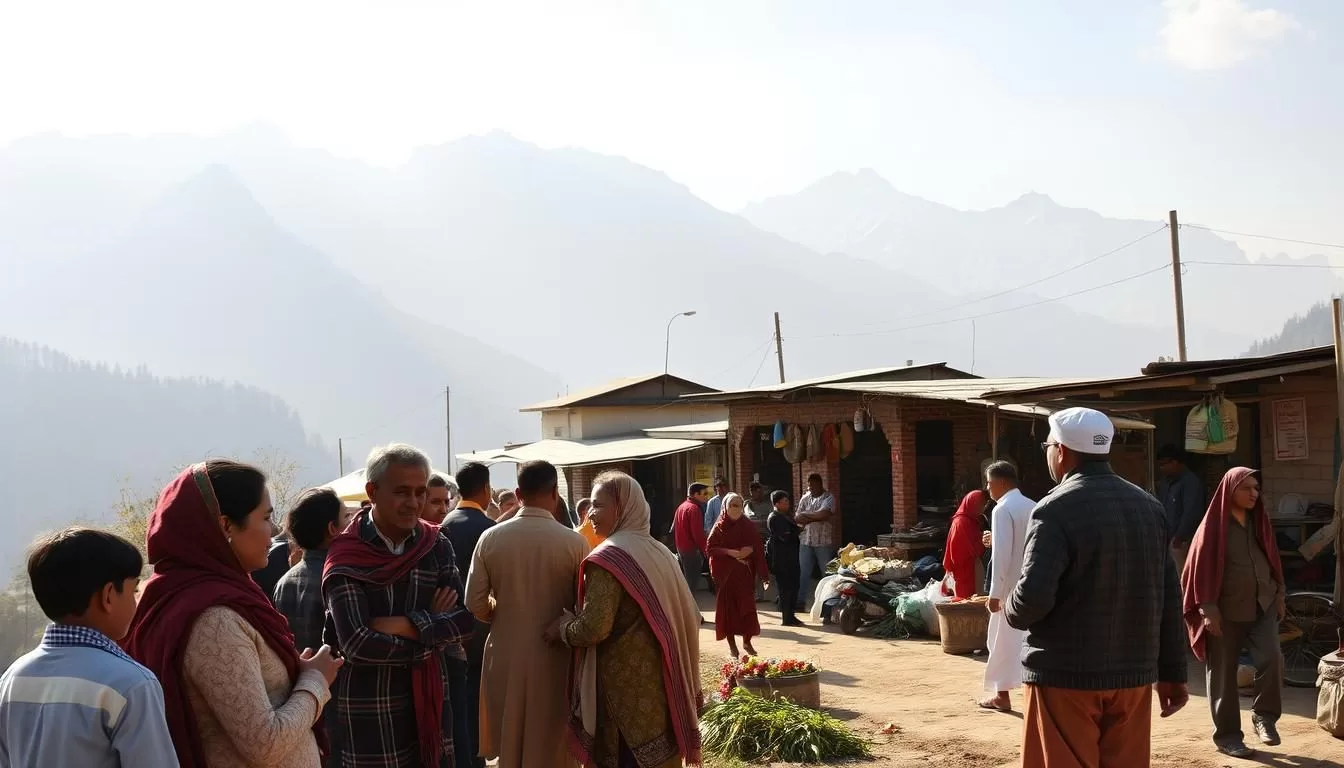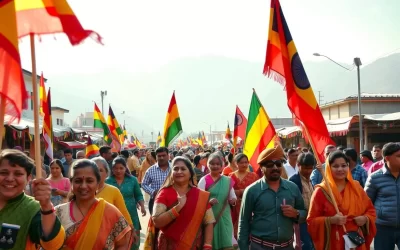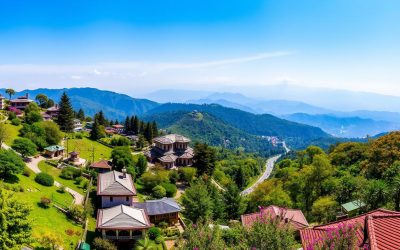✓ Accommodations✓ Flights✓ Rental Cars✓ Tours & Activities
As you explore the mountainous state of Himachal Pradesh in northern India, you’ll uncover a rich tapestry of languages that reflect the region’s cultural heritage.
The state’s diverse language landscape is shaped by its history, geography, and cultural identity. With Hindi and Sanskrit holding official status, you’ll find that various dialects are spoken across different regions.
Understanding the languages of this Himalayan state will enrich your appreciation of its cultural richness. Whether you’re planning to visit, study, or simply expand your knowledge, this guide provides valuable insights into the linguistic diversity of the region.
The Linguistic Landscape of Himachal Pradesh
With its unique geography and cultural context, Himachal Pradesh presents a fascinating case study in language diversity. The state’s position in the Western Himalayas has created a complex linguistic ecosystem.
Geographical and Cultural Context
Himachal Pradesh’s mountainous terrain has significantly influenced its linguistic development. Different languages have evolved in isolated valleys and regions, contributing to the state’s rich linguistic diversity. The state’s cultural context, including its historical connections to Tibet, Punjab, and other neighboring regions, has also shaped its language diversity.
The geographical isolation of various regions has allowed local languages and dialects to flourish. For instance, the Lahaul and Spiti district, being a cold desert area, has linguistic characteristics distinct from other parts of the state.
Overview of Language Diversity in the State
Himachal Pradesh is home to a variety of language groups, including Hindi and its dialects, Pahari languages, and tribal languages. The distribution of these languages varies across different regions, with certain dialects being more prevalent in specific valleys or districts.
The state’s language diversity is also reflected in its cultural practices and traditions. For example, the Pahari languages are closely tied to the cultural identity of the people living in the Pahari regions.
| Language Group | Major Languages/Dialects | Regions Predominantly Spoken |
|---|---|---|
| Hindi and Dialects | Standard Hindi, Pahari Hindi | Urban areas, plains, and some hill regions |
| Pahari Languages | Kangri, Mandeali, Kulluvi | Kangra, Mandi, Kullu districts |
| Tribal Languages | Kinnauri, Lahuli-Spiti languages | Kinnaur, Lahaul and Spiti districts |
Linguistic Demographics According to the 2011 Census
The 2011 Census provides valuable insights into the linguistic demographics of Himachal Pradesh. The data shows that the state’s total population of approximately 7 million people is distributed across various language communities.
According to the Census, Hindi is the predominant language, spoken by a significant portion of the population. Pahari languages and dialects are also widely spoken, particularly in the hilly regions.
The Census data also highlights the impact of urbanization on language use, with certain languages being more prevalent in urban centers compared to rural areas.
Official Languages of Himachal Pradesh
In Himachal Pradesh, the linguistic landscape is dominated by official languages that play a crucial role in government administration and public communication. You will find that the state’s language policy is designed to balance the promotion of official languages with the preservation of regional dialects and cultural heritage.
Hindi as the Primary Official Language
Hindi is recognized as the primary official language of Himachal Pradesh, serving as the main medium for government administration, education, and public services. You will observe that Hindi is widely used in official documents, public signage, and educational materials across the state. The use of Hindi as the official language is supported by constitutional provisions that mandate its use in government offices and public institutions.
The government of Himachal Pradesh has implemented various policies to promote the use of Hindi in official contexts. You will learn that these policies aim to ensure that Hindi is used effectively for administrative purposes, judicial proceedings, and public communication. The state’s commitment to promoting Hindi is reflected in its efforts to standardize language use across different departments and public services.
Sanskrit as an Additional Official Language
Sanskrit holds a unique position as an additional official language in Himachal Pradesh, a status granted by the state government to recognize its cultural and historical significance. You will discover that the government has initiated various programs to promote the study and preservation of Sanskrit, including educational initiatives and cultural events. These efforts aim to preserve the linguistic heritage associated with Sanskrit and promote its use in academic and cultural contexts.
The state’s recognition of Sanskrit as an official language underscores its commitment to preserving India’s rich cultural heritage. You will find that the government supports institutions dedicated to Sanskrit learning and promotes its study through various incentives and programs.
Devanagari: The Official Script
The Devanagari script is the official writing system for both Hindi and Sanskrit in Himachal Pradesh. You will understand that the use of Devanagari is widespread in official documents, public signage, and educational materials. The script plays a crucial role in maintaining consistency in language use across different contexts, from government administration to education.
The government of Himachal Pradesh has promoted the use of Devanagari through various initiatives, including educational programs and the standardization of language use in public services. You will observe that the use of Devanagari helps to ensure that both Hindi and Sanskrit are represented accurately and consistently across the state.
Hindi in Himachal Pradesh: Dialects and Regional Variations
The state of Himachal Pradesh presents a unique linguistic tapestry, with Hindi being spoken in various dialects and regional flavors. As you delve into the world of Hindi in this beautiful state, you’ll discover the rich diversity that exists within the language.
Standard Hindi and Its Usage
Standard Hindi, also known as Khari Boli, is widely used in Himachal Pradesh, particularly in urban centers, educational institutions, and media. You might notice that the Standard Hindi spoken here has its own nuances, differing slightly from the Hindi spoken in other states like Uttar Pradesh. This variation is largely due to the cultural and geographical context of the region.
In urban areas like Shimla, you’ll find that Standard Hindi is commonly spoken and understood by a significant portion of the population. It’s used in official communications, education, and formal events, serving as a unifying force across the state’s diverse linguistic landscape.
Pahari Hindi and Its Characteristics
Pahari Hindi is a distinctive variant of Hindi spoken in Himachal Pradesh, characterized by its unique vocabulary, pronunciation patterns, and grammatical features. This dialect is deeply influenced by the local cultural contexts and has developed distinct tonal qualities that differentiate it from Standard Hindi.
When you listen to Pahari Hindi, you’ll notice its melodic intonation and the use of words that are specific to the region’s cultural practices and traditions. The vocabulary is often infused with local idioms and expressions, making it a vibrant and expressive form of communication among the people of Himachal Pradesh.
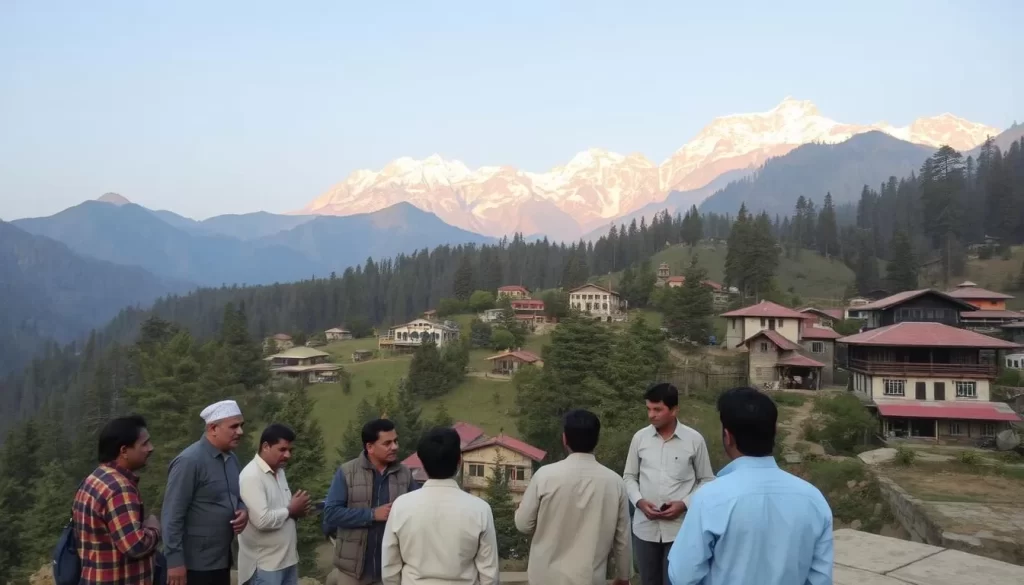
District-wise Hindi Dialect Variations
The Hindi dialects in Himachal Pradesh vary significantly across different districts, reflecting the state’s geographical diversity and historical connections. For instance, in districts like Kangra and Mandi, you’ll find distinct variations in pronunciation and vocabulary that are shaped by the local topography and cultural heritage.
In Shimla, the capital city, the Hindi dialect is influenced by its status as a major urban center, with a mix of standard and local dialectical features. As you travel to other regions, you’ll observe how the dialects change, often correlating with the topographical features of the area. For example, in the mountainous regions, the dialect might be more isolated and retain older linguistic features, while in the valleys, it might be more influenced by external factors.
Understanding these dialect variations is crucial for appreciating the linguistic diversity of Himachal Pradesh. It not only reflects the state’s rich cultural heritage but also highlights the adaptability and resilience of language in the face of geographical and cultural changes.
Pahari Languages of Himachal Pradesh
As you explore the linguistic landscape of Himachal Pradesh, you’ll discover the fascinating world of Pahari languages. These languages are not just a means of communication; they are carriers of the region’s rich cultural heritage and history. The Pahari languages belong to the Indo-Aryan language family and have evolved over centuries, influenced by the geographical and cultural context of the Himalayan region.
Western Pahari Language Group
The Western Pahari language group is a significant branch of the Pahari languages spoken in Himachal Pradesh. This group includes various dialects that have developed distinct features due to the region’s geographical diversity. The Western Pahari languages are known for their unique grammatical structures and vocabularies, which reflect the traditional practices and environmental conditions of their respective regions.
Some of the key characteristics of the Western Pahari language group include:
- Distinctive grammatical structures
- Vocabulary influenced by local traditions and environment
- Variations across different districts and valleys
Major Pahari Dialects: Kangri, Mandeali, and Kulluvi
Himachal Pradesh is home to several major Pahari dialects, including Kangri, Mandeali, and Kulluvi. Each of these dialects has its unique features and is spoken in specific regions of the state.
Kangri is predominantly spoken in the Kangra district and is known for its distinct pronunciation and vocabulary. Mandeali, spoken in the Mandi district, has its own set of grammatical rules and is an integral part of the local culture. Kulluvi, common in the Kullu valley, reflects the region’s cultural practices and traditional knowledge.
The distinctive features of these dialects include:
- Unique vocabulary and pronunciation
- Grammatical structures that reflect local cultural practices
- Usage patterns that vary across different social contexts
Relationship Between Pahari Languages and Hindi
The relationship between Pahari languages and Hindi is complex, with both similarities and significant differences. While Pahari languages are part of the Indo-Aryan language family, just like Hindi, they have developed distinct features over time.
Some linguists consider Pahari languages to be independent languages, while others view them as dialects of Hindi. The debate surrounding this issue is ongoing, with different perspectives on the linguistic classification of Pahari languages.
The challenges facing Pahari languages include:
- Preservation and documentation
- Intergenerational transmission
- Navigation between Pahari languages and Hindi in different contexts
In conclusion, the Pahari languages of Himachal Pradesh are a vital part of the state’s linguistic and cultural heritage. Understanding these languages provides insights into the region’s history, cultural practices, and the complex relationship between language and identity.
Tribal Languages and Linguistic Minorities
As you explore the remote regions of Himachal Pradesh, you’ll discover a fascinating array of tribal languages that reflect the state’s rich cultural diversity. Himachal Pradesh, known for its rugged terrain and diverse geography, is home to numerous tribal communities, each with their unique linguistic heritage.
The linguistic landscape of Himachal Pradesh is characterized by a multitude of languages, including several tribal languages that are spoken by smaller communities. These languages are an integral part of the state’s cultural identity.
Kinnauri and Lahuli-Spiti Languages
The Kinnaur district is home to the Kinnauri language, a Tibeto-Burman language with several dialects. Kinnauri is spoken by a significant population in the region and is an essential part of their cultural identity.
The Lahaul and Spiti districts are home to the Lahuli-Spiti languages, which show strong influences from Tibetan language families. These languages are spoken by communities living in the high-altitude regions of the state.
Tibetan Influence in Border Regions
The border regions of Himachal Pradesh, particularly areas adjacent to Tibet, have been significantly influenced by Tibetan culture and language. Buddhist cultural traditions have shaped language use in these regions, with many communities using Tibetan as a liturgical language.
Other Tribal Languages and Their Status
In addition to Kinnauri and Lahuli-Spiti languages, there are several other tribal languages spoken in Himachal Pradesh. These languages are often at risk due to the dominance of other languages and changing socioeconomic conditions.
The current status of these languages varies, with some being recognized in official contexts, while others remain unrecognized.
Key challenges facing these languages include:
- Lack of recognition in official contexts
- Limited access to education and services in their native languages
- Influence of dominant languages
Historical Evolution of Languages in Himachal Pradesh
As you explore the linguistic history of Himachal Pradesh, you’ll uncover a rich tapestry of languages that have evolved over thousands of years. The region’s unique geographical location and cultural exchanges have significantly influenced its linguistic landscape.
Ancient Linguistic Heritage
The ancient linguistic heritage of Himachal Pradesh is characterized by the presence of Sanskrit and Prakrit languages, which had a profound impact on the development of local dialects. Archaeological findings and textual evidence suggest that these languages were widely used in the region. The geographical isolation of the Himalayan valleys contributed to the preservation of archaic linguistic features in some dialects, making them valuable for understanding the linguistic evolution.
The influence of Sanskrit is still evident in many of the local languages and dialects spoken in Himachal Pradesh. You can observe this influence in the vocabulary and grammatical structures of these languages. For instance, many of the Pahari dialects have retained Sanskrit roots, showcasing the enduring legacy of this ancient language.
- The use of Sanskrit in ancient texts and inscriptions.
- The influence of Prakrit on local dialects.
- The preservation of archaic features in isolated Himalayan valleys.
Medieval Period and Language Development
During the medieval period, Himachal Pradesh witnessed significant language developments due to the influence of various kingdoms and dynasties. The region was ruled by different local powers, each contributing to the linguistic diversity. Languages such as Persian and Urdu also made their presence felt during this time, especially in the administrative and literary spheres.
The neighboring regions, including Punjab, Kashmir, and Tibet, played a crucial role in shaping the linguistic landscape of Himachal Pradesh. There was a considerable exchange of languages and dialects across these regions, resulting in a unique linguistic blend. For example, the Kangri dialect shows influences from neighboring languages, highlighting the region’s linguistic interconnectedness.

Colonial and Post-Independence Language Policies
The colonial period under British rule had a profound impact on the language use in Himachal Pradesh, particularly in administration and education. The introduction of English as a language of governance and education marked a significant shift. Post-independence, India witnessed a reorganization of states on linguistic lines, which affected Himachal Pradesh as well.
The establishment of Hindi as an official language was a significant decision that influenced the linguistic status quo in the state. The relationship between Hindi and regional languages was defined, with efforts made to promote Hindi while also acknowledging the importance of local languages. The government played a crucial role in shaping language policies, aiming to balance the promotion of official languages with the preservation of regional dialects.
- The impact of British colonial policies on language use.
- The establishment of Hindi as an official language post-independence.
- The role of government in shaping language policies.
In conclusion, the historical evolution of languages in Himachal Pradesh is a complex and fascinating narrative that reflects the region’s cultural, geographical, and political history. Understanding this evolution provides valuable insights into the current linguistic situation in the state.
Language and Education in Himachal Pradesh
As you explore the educational landscape of Himachal Pradesh, you’ll discover the significant impact of language on the learning experience. The state’s education system is characterized by a diverse linguistic environment, with multiple languages playing crucial roles in different contexts.
Medium of Instruction in Schools
The medium of instruction in Himachal Pradesh schools varies, with Hindi being the primary medium in government schools. English, on the other hand, is widely used in private schools and higher education institutions. This dual approach reflects the state’s linguistic diversity and the importance of both languages in different spheres of life.
- Hindi is used as the primary medium of instruction in government schools.
- English is predominantly used in private schools and higher education.
- Regional languages and dialects are also considered in the curriculum.
Language Curriculum and Policies
The language curriculum in Himachal Pradesh schools is designed to promote linguistic diversity while ensuring proficiency in key languages. Language education policies include teaching Hindi, English, and, in some cases, regional languages or Sanskrit.
- Hindi is taught as a compulsory subject.
- English is also a compulsory subject, reflecting its importance in higher education and professional contexts.
- Regional languages are included in the curriculum to preserve local linguistic heritage.
Challenges in Multilingual Education
Implementing multilingual education in Himachal Pradesh poses several challenges, including the availability of qualified teachers for diverse languages and the development of appropriate teaching materials. Students from different linguistic backgrounds often face difficulties navigating an education system that may not use their mother tongue as the medium of instruction.
- Availability of qualified teachers for regional languages.
- Development of teaching materials in diverse languages.
- Supporting students from varied linguistic backgrounds.
Despite these challenges, Himachal Pradesh is exploring innovative approaches to multilingual education, aiming to balance the preservation of linguistic heritage with the need for modern, globally relevant language skills.
Sanskrit’s Special Status in Himachal Pradesh
You might be surprised to learn that Sanskrit holds a special place in Himachal Pradesh, enjoying the status of an official language. This distinction is not common among Indian states, making Himachal Pradesh stand out in its reverence for Sanskrit.
Historical Significance of Sanskrit in the Region
Sanskrit has a rich historical significance in Himachal Pradesh, deeply intertwined with the region’s cultural and religious heritage. The language has been used in ancient temples, monasteries, and centers of learning throughout the state. You can still find numerous inscriptions and manuscripts in Sanskrit that date back to various historical periods, showcasing the language’s importance in the region’s past.
The tradition of Sanskrit scholarship in Himachal Pradesh has contributed significantly to the broader Sanskrit literary tradition. Many scholars from the region have made notable contributions to Sanskrit literature, philosophy, and science. The state’s cultural landscape has been shaped by Sanskrit, with many local traditions and festivals influenced by Sanskrit texts and rituals.
- The use of Sanskrit in ancient temples and monasteries highlights its religious significance.
- Sanskrit manuscripts found in the region provide valuable insights into its historical and cultural past.
- The tradition of Sanskrit scholarship continues to influence local culture and traditions.
Current Initiatives for Sanskrit Promotion
The government of Himachal Pradesh has launched several initiatives aimed at promoting and preserving Sanskrit in the state. These initiatives include funding for Sanskrit education, cultural activities, and the establishment of Sanskrit institutions. You can see a renewed interest in Sanskrit among the younger generation, thanks to these government efforts.
Specific programs have been implemented to support Sanskrit education and cultural activities. These include scholarships for students pursuing Sanskrit studies, workshops on Sanskrit language and literature, and the organization of cultural festivals that highlight Sanskrit’s role in Indian culture.
Sanskrit Educational Institutions in the State
Himachal Pradesh is home to several specialized Sanskrit educational institutions, ranging from traditional pathshalas to modern Sanskrit colleges. These institutions play a crucial role in preserving Sanskrit knowledge systems and promoting the language among new generations.
The curriculum in these institutions includes not only Sanskrit language and literature but also subjects like philosophy, grammar, and ancient Indian sciences. By providing a comprehensive education in Sanskrit, these institutions help maintain the language’s relevance in contemporary times.
As you explore the role of Sanskrit in Himachal Pradesh, it becomes clear that the language continues to have a significant impact on the state’s cultural identity. Efforts to preserve and promote Sanskrit are essential for maintaining this aspect of the state’s heritage.
Language and Administrative Functions
The administrative machinery of Himachal Pradesh operates within a linguistic framework that is predominantly shaped by the official language. As you explore how languages function within the state’s administrative system, you’ll gain insights into the practical implementation of language policies.
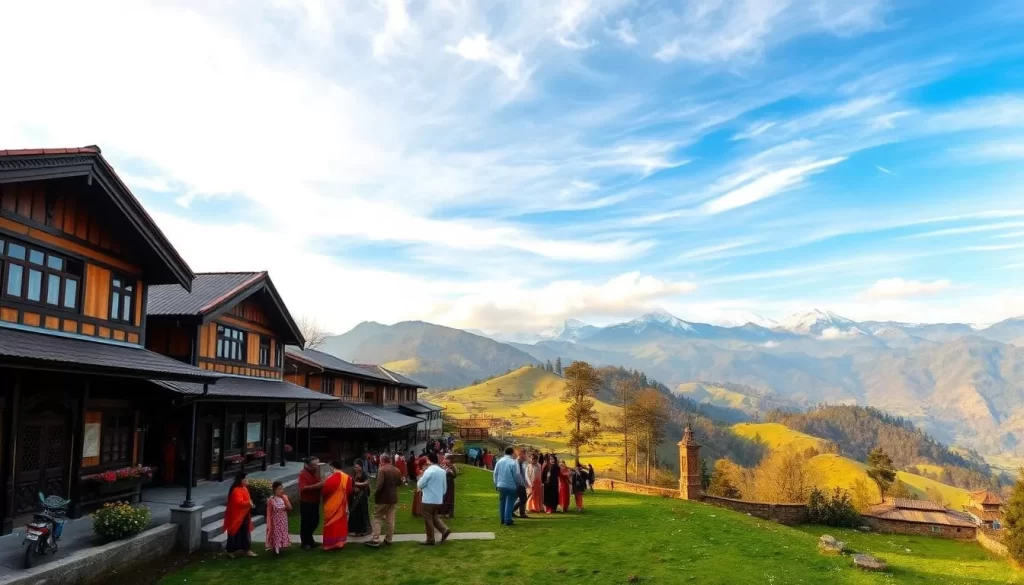
Administrative Language Use
In government offices across Himachal Pradesh, Hindi is the primary language used for official communications. This includes drafting documents, conducting meetings, and interacting with the public. The use of Hindi ensures that administrative functions are carried out efficiently and that citizens can access government services without language barriers.
You’ll find that regional languages and English also have a presence in administrative contexts, particularly in areas with significant tribal populations or in dealings with outsiders. This multilingual approach helps in catering to the diverse linguistic needs of the state’s population.
Judicial System and Language Policies
The judicial system in Himachal Pradesh operates with its own set of language policies. Court proceedings are primarily conducted in Hindi, although English is also used, especially in higher courts and legal documents. The High Court of Himachal Pradesh, for instance, uses both Hindi and English for judgments and legal proceedings.
Understanding the language policies in the judicial system is crucial for accessing justice. You’ll see that efforts are made to ensure that language is not a barrier to legal proceedings, with provisions for interpretation services when necessary.
Language Requirements for Public Services
To access public services in Himachal Pradesh, including healthcare, transportation, and social welfare programs, citizens are generally required to interact in Hindi. However, provisions are made for those not fluent in Hindi, ensuring that language does not become a barrier to accessing essential services.
You’ll learn that government offices and public service centers often have staff who can communicate in regional languages, facilitating easier access for citizens. Additionally, important documents and forms are made available in Hindi and sometimes in English to cater to a broader audience.
As you explore further, you’ll understand that the government of Himachal Pradesh is working towards enhancing language accessibility, including training for government employees in language proficiency and the use of translation services to bridge any language gaps.
Language and Cultural Identity in Himachal Pradesh
You will discover how the diverse languages of Himachal Pradesh are deeply intertwined with the cultural fabric of the region. The state’s linguistic diversity is a testament to its rich cultural heritage, with languages playing a crucial role in shaping the identity of its people.
Role of Language in Local Traditions and Festivals
Language is an integral part of the local traditions and festivals in Himachal Pradesh. Specific linguistic expressions, songs, and chants are used during cultural celebrations and religious practices, reflecting the region’s agricultural cycles and natural phenomena. For instance, during the Kullu Dussehra festival, traditional songs and hymns are sung in local dialects, adding to the festive atmosphere.
The use of local languages in these contexts not only preserves cultural heritage but also strengthens community bonds. You can observe how the linguistic elements incorporated into these festivals are unique to each region, showcasing the diversity within Himachal Pradesh.
- Traditional folk songs are sung during harvest festivals, celebrating the bounty of nature.
- Local dialects are used in storytelling, passing down historical narratives and myths.
- Chants and hymns in ancient languages are part of religious ceremonies, connecting the community with its spiritual roots.
Folk Literature and Oral Traditions
Himachal Pradesh is home to a rich tradition of folk literature, including tales, songs, proverbs, and riddles in various regional languages. These oral traditions have preserved historical narratives, ecological knowledge, and cultural wisdom through generations. The folk tales often reflect the region’s history, mythology, and the daily lives of its people.
For example, the Pahari folk tales are known for their vivid descriptions of nature and the supernatural, offering insights into the cultural and spiritual beliefs of the communities. These stories are passed down orally, with each retelling enriching the cultural heritage.
| Region | Folk Literature Example | Language/Dialect |
|---|---|---|
| Kangra Valley | Stories of local deities | Kangri |
| Kullu | Tales of mythical creatures | Kulluvi |
| Kinnaur | Legends of ancient kingdoms | Kinnauri |
Language as a Marker of Regional Identity
Language serves as a powerful marker of regional identity within Himachal Pradesh. People from different regions identify themselves linguistically, which shapes their sense of belonging to a particular community or region. The emotional connection people have with their mother tongues influences cultural preservation efforts, as communities strive to maintain their linguistic heritage.
You will notice how linguistic identity intersects with other aspects of cultural identity, including dress, cuisine, and social customs. For instance, the Pahari communities take pride in their distinct linguistic and cultural practices, which are reflected in their traditional attire and festivals.
The intersection of language with other cultural elements reinforces the unique identity of each region within Himachal Pradesh, contributing to the state’s overall cultural diversity.
Media and Communication Languages
You can observe a fascinating blend of languages in the media and communication landscape of Himachal Pradesh. The state’s linguistic diversity is reflected across various media platforms, including print, television, radio, and digital media.
Print Media in Himachal Pradesh
The print media in Himachal Pradesh is vibrant, with a range of newspapers, magazines, and literary publications. Hindi is the predominant language used in print media, catering to a wide readership across the state. However, regional languages such as Kangri, Mandeali, and Kulluvi also find representation in local newspapers and magazines.
The distribution and readership of Hindi publications are significantly higher compared to those in regional languages and English. Nonetheless, publications in regional languages play a crucial role in preserving local cultures and languages.
| Language | Type of Publication | Readership |
|---|---|---|
| Hindi | Newspapers, Magazines | High |
| Regional Languages | Local Newspapers, Magazines | Moderate |
| English | Newspapers, Literary Publications | Low to Moderate |
Television and Radio Broadcasting Languages
Television and radio broadcasting in Himachal Pradesh cater to the state’s linguistic diversity through multilingual programming. Doordarshan Shimla and All India Radio are prominent state-run channels that broadcast in various languages, including Hindi and regional languages.
News broadcasts, entertainment programs, and educational content are offered in multiple languages, ensuring that a wide audience is reached. Private channels also contribute to the linguistic diversity by broadcasting in different languages.
Digital Media and Language Use
The digital media landscape in Himachal Pradesh is growing, with an increasing number of people using social media and online platforms. Digital media accommodates different languages, with content available in Hindi, English, and regional languages.
Social media usage patterns vary across different language communities, with digital platforms being used to preserve and promote regional languages. However, creating digital content in regional languages and dialects poses challenges, including issues of script, standardization, and technical support.
In conclusion, the media and communication landscape in Himachal Pradesh is characterized by a rich linguistic diversity. As the state continues to evolve in its use of media and communication, it is likely that the role of different languages will also continue to adapt and grow.
Language Contact and Multilingualism
As you explore the linguistic landscape of Himachal Pradesh, you’ll discover a fascinating tapestry of language contact and multilingualism. The state’s unique geographical location and cultural diversity have created an environment where multiple languages coexist and influence one another.
Bilingualism and Code-Switching Patterns
In Himachal Pradesh, bilingualism is a common phenomenon, with most residents speaking at least two languages. This bilingualism is not limited to any particular region or social group; it’s widespread across the state. You’ll find that code-switching is a frequent occurrence in daily conversations, where speakers alternate between languages within conversations or even sentences.
- The use of multiple languages in a single conversation is influenced by various sociolinguistic factors, including the context of the conversation, the participants involved, and the topic being discussed.
- Code-switching serves multiple purposes, such as establishing identity, conveying social status, or simply facilitating clearer communication.
- This linguistic flexibility is a hallmark of multilingual communities like Himachal Pradesh, where language use is highly adaptive and context-dependent.
Influence of Neighboring State Languages
The languages spoken in Himachal Pradesh have been influenced by neighboring state languages, including Punjabi, Haryanvi, and Uttarakhandi. This linguistic exchange has enriched the local languages, introducing new vocabulary and grammatical structures. The influence is evident in the various dialects spoken across different regions of the state.
Some specific linguistic features borrowed from neighboring languages include:
- Phonetic variations that are characteristic of neighboring languages.
- Loanwords that have been incorporated into local vocabularies.
- Syntactic structures that reflect the influence of neighboring linguistic traditions.
Impact of Tourism on Language Use
Tourism, being one of Himachal Pradesh’s major industries, has significantly impacted language use in popular destinations like Shimla, Manali, and Dharamshala. Local people in tourist areas have adapted their language practices to communicate effectively with visitors from across India and around the world. This has led to an increase in the use of English and other international languages in these regions.
The impact of tourism on language use is multifaceted:
- There’s an increased demand for language skills that cater to tourists, such as English language proficiency.
- Local languages are being influenced by the languages spoken by tourists, leading to a more diverse linguistic landscape.
- The economic benefits of tourism have also led to a greater appreciation and preservation of local languages and cultures.
In conclusion, language contact and multilingualism are integral to the linguistic identity of Himachal Pradesh. The state’s bilingualism and code-switching patterns, the influence of neighboring state languages, and the impact of tourism on language use all contribute to its rich linguistic diversity.
Language Preservation Efforts
Efforts to conserve the linguistic heritage of Himachal Pradesh are gaining momentum, involving government initiatives and community participation. You are about to explore the various strategies being implemented to preserve the languages of this Indian state.
Government Initiatives for Language Conservation
The government of Himachal Pradesh has launched several initiatives aimed at conserving the state’s linguistic diversity. These include establishing language academies and providing financial support for language documentation projects. You will find that these initiatives are crucial for the survival of endangered languages in the region.
Some of the key government programs focus on promoting the use of local languages in education and government services. For instance, the state government has introduced programs to teach local languages in schools, thereby encouraging the younger population to learn and appreciate their linguistic heritage.
| Initiative | Description | Impact |
|---|---|---|
| Language Academies | Establishment of academies to promote and preserve local languages | Promotes linguistic diversity and provides a platform for language learning |
| Language Documentation Projects | Financial support for documenting endangered languages | Preserves linguistic heritage for future generations |
| Local Language Education | Introduction of local languages in school curricula | Encourages younger generations to learn and appreciate local languages |
Documentation of Endangered Languages
Documentation of endangered languages is a critical aspect of language preservation efforts in Himachal Pradesh. You will learn about the various methods being used, including audio-visual recordings, dictionary creation, and grammar development. Academic institutions, researchers, and non-governmental organizations are playing a vital role in these documentation projects.
The documentation process not only helps in preserving the language but also provides valuable resources for language learners and researchers. It involves creating archives of language samples, which can be used for educational purposes and to promote the language.
Community-Based Language Revitalization Projects
Community-based language revitalization projects are at the heart of language preservation efforts in Himachal Pradesh. These projects empower the speakers of endangered languages to take an active role in preserving their linguistic heritage. You will discover how these projects are making a difference in various parts of the state.
Some successful case studies from Himachal Pradesh demonstrate the effectiveness of community-led initiatives. These projects often involve language immersion programs, cultural events, and the development of language learning materials. They not only help in revitalizing endangered languages but also contribute to the cultural and social well-being of the communities involved.
By supporting community-based language revitalization projects, you are contributing to the preservation of Himachal Pradesh’s rich linguistic diversity. These efforts are crucial for maintaining the cultural identity of the people and ensuring that their languages continue to thrive.
English and Other Non-Indigenous Languages in Himachal Pradesh
As you explore the linguistic landscape of Himachal Pradesh, you’ll notice the significant presence of non-indigenous languages. This Indian state, known for its cultural richness and diversity, has embraced languages beyond its local dialects, particularly in education, administration, and tourism.
The role of English in Himachal Pradesh is multifaceted. It serves as a crucial link language in education, administration, and tourism, facilitating communication among people from different linguistic backgrounds.
Role of English in Education and Administration
English plays a vital role in the education system of Himachal Pradesh, from primary schools to universities. It is not only a subject of study but also a medium of instruction for many schools, especially private and English-medium institutions. The importance of English is recognized as a key to accessing global knowledge, enhancing career opportunities, and participating in the global economy.
In administration, English is widely used in government offices, particularly for official communications, documentation, and higher-level administrative purposes. This use of English helps in maintaining uniformity and facilitating communication with other states and the central government.
The attitude towards English varies among different segments of Himachal Pradesh’s population. While some view it as a necessary tool for social mobility and career advancement, others see it as a symbol of modernity and global connectivity.
Foreign Languages in Tourism Sector
Himachal Pradesh’s tourism industry has led to an increased presence of foreign languages, particularly in areas frequented by international tourists. Languages such as French, German, Hebrew, and Japanese have found niches in popular tourist destinations, catering to the needs of visitors from diverse linguistic backgrounds.
To enhance the quality of service and facilitate cultural exchange, language training programs are being implemented for tourism professionals. These programs focus on teaching relevant foreign languages to those in the tourism industry, enabling them to better serve international tourists and provide a more enriching experience.
Migrant Communities and Their Languages
The linguistic diversity of Himachal Pradesh is further enriched by migrant communities, including seasonal workers, long-term residents, and refugees. Languages like Nepali, Bengali, and Tibetan have established a presence in certain parts of the state through migration.
These migrant communities maintain their languages while adapting to the local linguistic environment. This has led to a unique linguistic mosaic where local and migrant languages coexist, contributing to the cultural richness of the region.
Some key aspects of the linguistic diversity brought by migrant communities include:
- Maintenance of their native languages through community efforts
- Adaptation to local languages, particularly Hindi and Pahari dialects
- Cultural exchange and enrichment through linguistic diversity
- Contribution to the economic and social fabric of Himachal Pradesh
In conclusion, the presence of English and other non-indigenous languages in Himachal Pradesh reflects the state’s adaptability and openness to diverse linguistic influences. As the state continues to evolve, the role of these languages is likely to remain significant.
Challenges and Future of Languages in Himachal Pradesh
As you explore the linguistic landscape of Himachal Pradesh, you’ll encounter numerous challenges facing the languages spoken in this region. The state’s rich linguistic diversity is threatened by various factors, including demographic changes, educational policies, and economic pressures. Understanding these challenges is crucial to appreciating the complexities of language preservation in Himachal Pradesh.
Endangered Languages and Dialects
Himachal Pradesh is home to a number of languages and dialects that are considered endangered or vulnerable to extinction. The Western Pahari language group, for instance, encompasses several dialects that are at risk due to decreasing numbers of fluent speakers, particularly among younger generations. Factors contributing to language endangerment include urbanization, migration, and the increasing dominance of Hindi and English in official and educational contexts.
The potential loss of these languages is not just a linguistic issue; it also has significant cultural and identity implications for the communities that speak them. Efforts to document and preserve these languages are underway, but more needs to be done to ensure their survival.

Impact of Globalization and Migration
Globalization and migration patterns are significantly impacting language use patterns in Himachal Pradesh. As people move to urban areas or migrate to other parts of the country for work, there’s a noticeable shift towards more widely spoken languages like Hindi and English. This shift can lead to a decline in the use of local languages, especially among younger people who may see these languages as less relevant to their future prospects.
The impact of globalization is also felt through media and technology, where English often dominates. This can further marginalize local languages, making it challenging to maintain linguistic diversity in the face of global cultural homogenization.
Balancing Linguistic Heritage with Modern Needs
The challenge for Himachal Pradesh is to balance the preservation of its linguistic heritage with the need for modern communication. This involves finding ways to promote the use of local languages in new domains, such as digital media, while also ensuring that younger generations have access to the opportunities that proficiency in Hindi and English can provide.
Innovative approaches to language planning and education are being explored to address this challenge. These include bilingual and multilingual education programs that value local languages while also teaching widely spoken languages. By adopting such approaches, Himachal Pradesh can work towards a future where its linguistic diversity is preserved and valued.
Conclusion: The Linguistic Mosaic of Himachal Pradesh
As you’ve discovered, Himachal Pradesh is home to a rich linguistic heritage, with a multitude of languages playing important roles in the state’s identity. The state’s linguistic mosaic is characterized by the presence of Hindi as the official language, alongside Sanskrit, which holds a special status due to its cultural significance.
You’ve explored how Pahari languages and dialects form a crucial part of Himachal Pradesh’s cultural heritage, contributing to the state’s unique identity. The diverse regional dialects and tribal languages add to the richness of the linguistic landscape, making Himachal Pradesh a fascinating case study in linguistic diversity.
The challenges facing minority and endangered languages in the state are significant, but efforts are being made to preserve them through documentation and community-based projects. Understanding how Himachal Pradesh’s linguistic situation compares to other Indian states like Uttar Pradesh and West Bengal highlights both similarities and differences, showcasing the unique character of each region.
Languages in Himachal Pradesh serve as a link between past traditions and contemporary life, playing a vital role in the state’s cultural sustainability. As you look to the future, it’s clear that preserving linguistic diversity will be crucial for maintaining the state’s cultural heritage.
For those interested in further exploration, Himachal Pradesh offers numerous opportunities to engage with its languages through travel, study, or cultural resources. By embracing this linguistic diversity, you can gain a deeper understanding of the state’s identity and its people.
The above is subject to change.
Check back often to TRAVEL.COM for the latest travel tips and deals.
